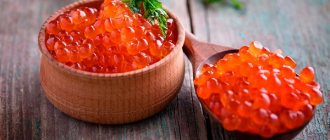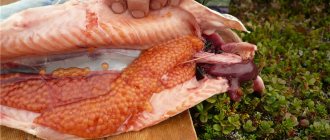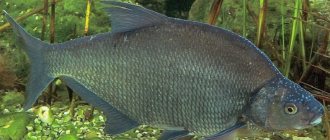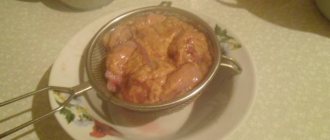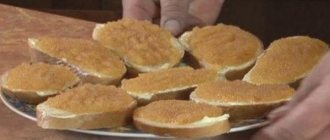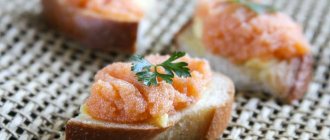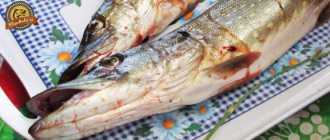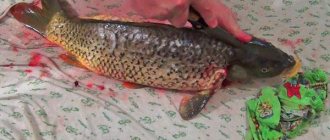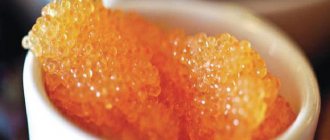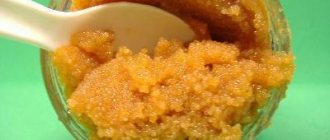In terms of its beneficial properties, pike caviar ranks third after red and black. It is considered a dietary product due to its low fat content. In addition, pike caviar is an affordable source of proteins, trace elements and other useful substances.
That is why it is worth learning how to salt pike caviar at home in order to enjoy this delicious and healthy dish at any time. In this article we will tell you how to properly salt pike caviar at home in different ways.
Useful properties of pike caviar
Considering the taste characteristics, this type of caviar can easily count on one of the leading positions. Only sturgeon and salmon caviar can compete with its taste. However, it is valued not only because of its high taste. The beneficial properties of pike caviar are that it contains a huge amount of protein, which is perfectly absorbed by the body. The body needs protein as a building material. Therefore, consuming pike caviar leads to noticeable improvements in health.
The presence of Omega-3 has a great impact on improving well-being. Polyunsaturated acids are necessary for both a growing body and an aging one. They protect cells from destruction, which has a positive effect on appearance. The skin loses its elasticity more slowly, and a person retains youth longer.
In addition, they can trigger the process of cell repair, which can be quite significant in the presence of certain diseases. Pike caviar will also help patients diagnosed with high cholesterol. After all, Omega-3 easily cleanses blood vessels of fatty plaques, resulting in improved functioning of the heart and blood vessels.
Vitamins A and B play a major role in renewing the body and maintaining its immunity. They are necessary to ensure healthy skin, hair and nails. The presence of iodine allows you to normalize metabolic processes. All this will lead to stabilization of weight, eliminating sudden jumps. In addition, the presence of iodine helps eliminate abnormalities in the thyroid gland.
As a result, this will provoke an improvement in well-being, as the person begins to experience a surge of strength. With periodic consumption of pike caviar, the feeling of fatigue goes away. The product has virtually no contraindications, with the exception of children under 3 years of age. In this case, doctors do not recommend that parents feed their children caviar, as it contains too much collagen.
What you need for pickling
Numerous recipes aimed at preparing the royal delicacy are distinguished by the presence of various ingredients, the basis of which is all kinds of seasonings.
For pickling you will need the following ingredients:
- Pike caviar or fish with caviar. Please note: the degree of maturity of pike caviar also determines its grain size. Pike spawns earlier than other fish, but the caviar of any winter species is well suited for salting. Fish caught in January-February have coarser-grained eggs.
- To rinse the caviar well, you will need a lot of clean water.
- You can use fine regular salt or coarse sea salt.
- Sunflower oil (not always used).
To clean caviar you will need certain equipment:
- Sieve.
- Colander.
- Grater.
- Whisk.
- Fork.
- Knife.
- Container for pickling.
Be patient, because preparing caviar is a rather labor-intensive process.
Preparing pike caviar
To obtain caviar, you need to select the right individual. A good choice would be fish around 2-3 kg, caught right before spawning. Large caviar can be obtained from an individual caught in January-February. In addition, to prepare pike caviar, you need fresh fish. It is thoroughly cleaned and gutted, using the utmost care. If you are not careful, you can damage the gallbladder, then the leaked liquid will give the fish and caviar a bitter taste.
The caviar is located inside the belly of the fish, it is in a thin film. Therefore, you need to pull it out carefully, because the film can tear and the eggs will fall out. Essentially, the eggs are in bags that need to be rinsed under water. This must be done with care and thoroughness so that the eggs do not scatter, and all remnants of blood and entrails are washed off with water. Clean bags filled with caviar must be separated from the film.
There are several ways to do this:
- Pass through a meat grinder.
The simplest method of getting rid of film, invented by fishermen. In this case, the bags are placed in the bowl of a meat grinder and passed through it. Ideally, the film should be wound around the knives, and the output should be clean caviar. However, the method is fraught with some danger, which can increase the time it takes to clear caviar from films. If the knives of the device are too sharp, the meat grinder will simply shred the film. As a result, pieces of the film will be mixed with the caviar and it will be much more difficult to get them out. - Remove using a mixer.
The method is simple: the film will be wound around the rims of a working device. Therefore, it will be quite easy to clean the caviar from the bags. However, you should not use too fast speed modes, because the film may simply tear. - Use a grater.
This method requires using the larger mesh side of the grater to allow the eggs to pass through freely. The bags are simply pressed through a grater, the eggs pass through the holes, and film particles remain outside. - Pass the bags through a sieve.
The method is very similar to the grater method, only here a sieve is used. The caviar will come out through the holes, and the remaining film will remain in the sieve. - Hot water method.
For this method, you need a bowl; bags of caviar are placed in it. Pour hot water on top and stir with a fork until the bags burst. After this, pieces of the film will begin to float up; to completely clean the product, you need to carry out the procedure several times. After removing all residues, pour cold water into a bowl and rinse the caviar. At the end, pour the water with caviar onto a colander or sieve lined with gauze. Leave the water to drain and check again for possible traces of films. - Using a knife.
It is not necessary to use devices to clean caviar. An ordinary knife is quite enough; for this, an incision is made in the bags. The caviar must be carefully squeezed out through the resulting hole. - Using a fork.
The method is quite simple, but requires some skill. You need to make a small hole in the caviar bubble. Then you need to take a fork in one hand and carefully hold the bag with the other. Using cutlery, carefully remove the eggs from the film.
Salting delicious caviar with vinegar
This is also a quick recipe for preparing a delicacy. Not in 5 minutes, but in 2 hours, you will get a wonderful salad appetizer. It is better to prepare the dish from fresh caviar, but if you come across frozen caviar, this should not be an obstacle. The treat will be amazingly tasty.
- Caviar - 500 gr.
- Vinegar 3% - 3 large spoons (dilute regular table vinegar three times).
- Sunflower oil - the same amount.
- Bulb.
- Green onions - a few feathers.
- Ground pepper, salt.
- Remove the oysters from the gutted pike and separate the grains.
- Boil water, pour in the product. Hold for about 10 minutes. When the grains turn white, drain the liquid.
- Place in a bowl, add finely diced onions, season with oil and vinegar. Season with pepper and salt.
- Stir the salad and leave to steep for 2 hours.
- When serving, garnish with finely chopped green onions.
Cold salting of pike caviar
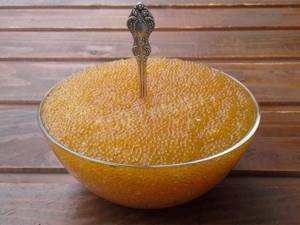
Cold salting is one of the most popular methods of preparing pike caviar. With this method, the caviar turns out thick and very aromatic. However, it will take longer to infuse than with hot cooking.
The proportions are as follows:
- pike caviar – 0.5 kg;
- salt – 3 tbsp. l.
Preparation:
- Place pike caviar in a bowl and add salt on top.
- Next, the mixture of caviar and salt must be stirred until white foam appears. It usually takes a few minutes.
- Excess foam must be removed and the caviar transferred to a clean jar. The jar must be tightly closed with a lid and placed in the refrigerator.
- Caviar should be infused in the refrigerator for at least 2 days. Otherwise, the product simply will not have time to salt and will be hazardous to health.
- After 2 days, the foam in the caviar will disappear and the product will become thick.
{banner_vnutri-kontenta-3}
Salting methods at home
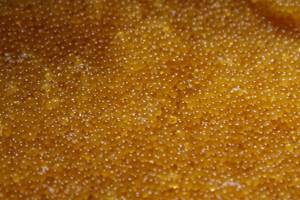
It may seem that salting caviar at home requires a lot of time and many additional ingredients. And why bother with such a complicated matter when there is such a large selection in stores. However, no special ingredients are required for salting pike caviar; all of them are already in the housewife’s kitchen; to reduce the time, you can use a quick recipe.
Hot salting of pike caviar
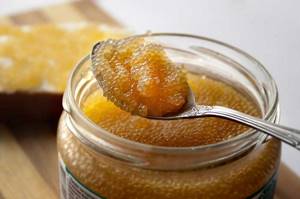
This salting recipe came from the north; the Yakuts prepare almost any caviar using a similar method. Pike caviar cooked using the hot method is less salty than when cooked using the cold method. It is just as tasty, but due to the peculiarities of salting it turns out lighter and thinner. Hot cooked caviar can be stored for no more than 3 days.
The proportions are as follows:
- caviar – 500 g;
- salt – 2 tbsp. l.;
- water – 1 l;
- vegetable oil – 2 tbsp. l.
Preparation:
- Pour water into the pan and add salt. Salted water must be brought to a boil. To prepare caviar, the liquid must be at least 80 degrees. Usually the liquid reaches this temperature in 10 minutes.
- Pour pre-cleaned and washed caviar into boiling water. The pan must be kept on the fire for at least 5 minutes, the caviar must be stirred constantly.
- After cooking, the cooked caviar must be placed on cheesecloth. The product should lie for about 10 minutes so that the water drains and the caviar cools down.
- At the end, add vegetable oil and beat until foam appears. This is necessary for the caviar to thicken.
- Place the finished product in a clean jar and remove excess foam. The jar is tightly closed and then put in the refrigerator.
- In the refrigerator the product will infuse and be finally salted. With the hot cooking method, caviar will be ready after 6-7 hours.
Saline method
In previous methods, it was necessary to add salt directly to the caviar. To do this, you need to beat it with a fork, which disrupts the structure of the eggs and spoils the appearance of the product. If you use a saline solution called brine, the grains will remain round and whole.
Cooking process:
- Caviar in bags is taken from the fish carcass, cleaned of films and placed in a deep vessel. Next, it is washed several times under hot and cold water to destroy parasites.
- A saturated saline solution is prepared in a separate container. For 1 liter of water you will need several tablespoons of salt. It is better to use boiling water to further disinfect the caviar.
- Pour the prepared solution into pike caviar and let it steep for 30 minutes. Next, the mixture is poured into a sieve to remove excess liquid. Caviar is ready to eat.
You can add a small amount of vegetable oil to the finished caviar. Additional ingredients include green or onions and spices to taste.
Recipes for salting pike caviar are not much different. This is due to the fact that pike caviar has its own rich taste and aroma and does not require the addition of spices. The main purpose of salting it is to get rid of parasites and other microorganisms that may be in it and transmitted to humans. Caviar can be served on the table in a separate container, and pancakes can be placed on a nearby dish. There are also recipes for sandwiches and tartlets with butter and pike caviar. It goes well with fresh vegetables and green onions.
Quick salting of pike caviar
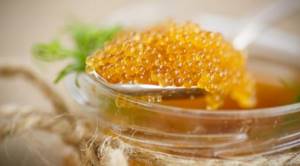
If the fish you come across is small and there is very little caviar, then you can use a quick method of salting pike caviar. Unlike other methods, salting in this way will allow you not to wait several hours or even days to get the finished product. The method is based on the hot method, but the caviar is not boiled, but poured with boiling water.
The proportions are as follows:
- pike caviar – 300 g;
- hot water (boiling) – 1 l;
- salt – 1 tbsp. l.
Preparation:
- The prepared caviar is placed in a metal container, and salt must be poured on top.
- Then the caviar is poured with boiling water, the mass must be stirred constantly. The caviar must be kept under hot liquid for about 5 minutes.
- Then the caviar must be pulled out and washed with cold water.
- Clean caviar should be strained through cheesecloth and allowed to sit for a little while to allow the remaining liquid to drain out.
- Then beat the caviar, removing excess foam. And the finished product needs to be put into jars.
- The jar of caviar must be kept in the refrigerator for 40 minutes. The product will be salted and finally ready.
How to salt pike caviar: lightly salted salting recipe
The amount of salt is the main secret to success when salting absolutely any caviar. Sometimes you want to try a lightly salted dish, which can be prepared especially quickly.
The ratio of ingredients here is:
- 500 g pike caviar;
- 1 tablespoon salt (20-25 g);
- several glasses of boiling water.
Accordingly, the proportions of salt and fresh pike caviar during salting will be as follows:
- for 1 kg of fresh product you will need to take 2 tablespoons of salt;
- if you want to try a saltier dish, you should take 1.5 spoons per 500 g and 3 spoons per 1 kg;
- if there is very little caviar, it is enough to get by with a small pinch or accurately calculate the number of grams based on this ratio (a teaspoon - 10 g, a tablespoon - 20 g).
How to salt at home:
Step 1. First, the fish is gutted, and the eggs are necessarily taken out of the egg shell - this is a natural, rather dense shell, which is a kind of bag.

Step 2. Transfer the product to a plate and pour boiling water so that it completely covers the eggs. This is done to sterilize against bacteria.

Step 3. After 10-15 minutes, the water is drained, the product is thrown onto a sieve and washed several times with running water.

Step 4. Now let’s start with the actual salting. Place the salt in the dish and stir it carefully and thoroughly - using your hands so as not to damage the eggs.

Step 5. Then the caviar needs to rest a little. Soon it will begin to separate foam, which you just need to remove with a spoon.

Step 6. The last step is to put the plate in the refrigerator overnight (6 hours is enough). Salted pike caviar is completely ready.
It can be spread on bread and butter or simply served with toast and greens. It is appropriate to garnish the dish with green onions, and for those who like spicy food, add a little black pepper during cooking.
Pike caviar is delicious for sandwiches
We salt the caviar ourselves. We clear the film.
Before removing the film, you must first remove it from the fish. You need to act very carefully so as not to damage. First, the abdomen is cut, and then the bags with caviar are carefully removed. You need to take it out with extreme caution so as not to damage the eggs, so that bile does not get into them and spoil the taste of the caviar.
Why do you need to remove films?
The film (jastik) is needed to keep the eggs together. It is not harmful in itself, it can be eaten, but it gives a very unpleasant aftertaste to such a dish. It becomes bitter, and the caviar is not as crumbly as we would like.
What will you need?
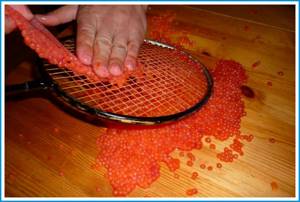
There are many different ways that help you quickly and efficiently get rid of ulcers on your calf. But first, everything is thoroughly washed in a large container. For each type of fish there is a separate cleaning method that is most suitable for a certain type and size of grains.
For some, you need a regular fork on which the film is wound and carefully removed. For others, you need a sieve with large holes through which the particles are pressed, and the film remains on the sieve.
